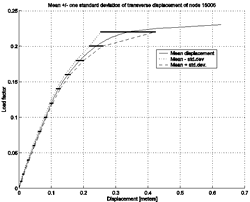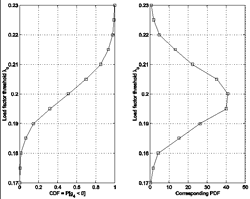| Project Title/ID Number |
Computational Reliability
Tools for Design—4142003 |
| Start/End Dates |
10/1/03—9/30/04 |
| Project Leader |
Armen Der Kiureghian (UCB/F) |
| Team Members |
Kazuya Fujimura (UCB/GS), Junho
Song (UCB/GS) |
F=faculty; GS=graduate student; US=undergraduate student; PD=post-doc; I=industrial
collaborator; O=other
Click on images to enlarge in a new window
1. Project Goals/Objectives:
-
Develop, implement, document and apply reliability and sensitivity
methods in the OpenSees computational simulation framework.
-
Identify and
track the propagation of uncertainties through the probabilistic performance-based
earthquake engineering assessment procedure.
-
Develop parameter importance
and sensitivity measures.
-
Investigate performance criteria (limit-state
functions) applicable to non-linear degrading reinforced concrete structures
under static and dynamic
effects.
-
Apply reliability methods to the I880 test bed.
Specific goals for Year
7 include:
-
Implement efficient and robust methods for reliability analysis
of inelastic structures under stochastic loading, including importance-sampling
methods.
-
Enhance reliability models and computational tools to solve “systems” problems
characterized by multiple limit-state functions (multi-criteria performance).
-
Develop
and implement random field models.
-
Further develop the application to the
I-880 test bed.
2.
Role of this project in supporting PEER’s mission
(vision):
This project supports the PEER strategic plan by providing an advanced
tool for uncertainty and reliability analysis in OpenSees. These tools
are essential for performance-based earthquake engineering analysis and
design. Analysis options include propagation of uncertainties, sensitivity
analysis, reliability and fragility assessment, and parameter importance
measures.
3. Methodology Employed:
Use is made of the following methodologies:
-
Response sensitivity analysis
by the direct differentiation method (DDM),
-
The first-order second-moment
(FOSM) method for analysis of uncertainty propagation,
-
The first-order
reliability method (FORM) for reliability and fragility analysis,
-
Importance
sampling and Monte Carlo simulation methods for uncertainty propagation
and reliability analysis,
-
Stochastic representation of ground motion
in the form of a filtered train of random pulses,
-
The FORM for reliability
sensitivity and parameter importance measures, and
-
For stochastic dynamic
problems, FORM and importance sampling methods are used to compute
out-crossing rates and first-excursion
probabilities.
These methods are all implemented in the open-source, object-oriented
platform OpenSees and are readily available for download
from the web.
4. Brief Description of past year’s accomplishments
(Year 6) & more detail on expected Year 7 accomplishments:
Terje Haukaas posted a fully functioning version of the sensitivity and
reliability modules of OpenSees last year with the completion of his Ph.D.
thesis in August 2003. The thesis by Haukaas documents the theory and formulation
of sensitivity, uncertainty and reliability methods and their implementation
in OpenSees. Guides for users and developers are also presented. A slightly
modified version of this thesis has been submitted for publication as a
PEER report. An important part of this study is a comprehensive application
of sensitivity, uncertainty and reliability analysis to the I880 test bed
viaduct. This application demonstrates the use of the reliability tools
in OpenSees for a “real-world” problem with thousands of degrees
of freedom and hundreds of random variables. Also investigated is the relative
importance of various sources of uncertainty on the performance of the viaduct.
Selected results from this application are presented below.
Figure 1 shows
uncertainty propagation in probabilistic pushover analysis of the viaduct.
The results show that the uncertainty in the displacement
for a given load rapidly increases with loss of stiffness. A similar but
less dramatic increase is observed in the uncertainty of the load for
a given displacement. Figure 2 shows the cumulative distribution and probability
density functions of the displacement and load when the lateral stiffness
reaches 20% of the initial stiffness.
 (a)
(a)  (b)
(b)
Figure 1. Mean and mean ± standard deviation of (a) displacement
for given load,
(b) load for given displacement.
 (a)
(a)  (b)
(b)
Figure 2. CDF and PDF of displacement (a) and load (b) at 20% of elastic
tangent.
The application to I880 test bed also helped us identify areas where further
development is needed. Specifically, our experience showed that for stochastic
dynamic problems there is need for more robust and efficient reliability
algorithms for application to “real-world” structures. One of
the main goals of Year 7 is focused on this development. We are currently
developing and implementing efficient algorithms for application to “real-world” structures.
5. Other Similar Work Being Conducted Within and Outside
PEER and How This Project Differs:
Finite element reliability codes have been developed and used by NASA,
Boeing, Southwest Research Institute, Los Alamos and a few other entities.
General-purpose reliability codes have been developed at the Technical
University of Munich (STRUREL), Det Norske Veritas (PROBAN), the University
of California, Berkeley (CalREL) among others. The on-going development
in OpenSees is unique in several aspects. This is the first general-purpose
finite element reliability code developed in the open-source, object-oriented
programming paradigm and it is the first code to handle nonlinear structures.
Other researchers within PEER (G. Fenves at UCB, J. Conte at UCSD) are
also working on DDM sensitivities in OpenSees. These groups are using the
framework developed by our prior research. Their work is complementary,
as each group addresses a particular element or material within OpenSees.
We are also aware of theoretical work in this area by researchers in MCEER
and are following it with interest.
6. Plans for Year 8 if project is expected to be continued:
-
A long-term goal of this project is to develop and implement tools
for random field reliability analysis allowing the modeling of uncertain
media, such as soils. A framework and initial implementation of this method
is targeted for completion by September 2004. In Year 8, we would like to
start implementation of this methodology in OpenSees.
-
Another objective is
to incorporate tools for model uncertainty analysis in OpenSees. It is intended
to use Bayesian uncertainty analysis methods
to assess the model error based on laboratory and field observations, and
incorporate it in reliability assessment.
-
We would like to expand the library
of stochastic ground motion models and corresponding simulation algorithms
in OpenSees.
-
We believe there is need for promoting use of advanced reliability
methods in practical performance-based engineering by demonstrating the
use of probabilistic
tools available in OpenSees to comprehensive real-world problems. We intend
to develop such demonstrative examples in Year 8 for increasingly more
elaborate applications.
7. Describe any actual instances where you are aware your
results have been used in industry:
We are communicating with a diverse group of approximately 30 researchers
within and outside PEER, who have reported interest in performing reliability
and response sensitivity analysis with OpenSees. This number is expected
to grow, as OpenSees becomes a simulation tool for NEES. The reliability
modules in OpenSees are also used in graduate courses at UC Berkeley. The
PI will be teaching a course this summer in Italy, where this software
will also be used.
8. Expected Milestones & Deliverables:
-
Development and implementation methods for reliability analysis
under dynamic loads. March 31, 2004.
-
Implement new algorithms for reliability analysis with multiple performance
criteria. July 2004.
-
Implement improved importance sampling and other simulation methods.
July 2004.
-
Carry out reliability analysis of I-880 test bed using the improved
algorithms. These improvements will allow reliability analysis for
dynamic loads,
accounting for nonlinear behavior of the bridge. September 2004.
-
Develop and implement tools for random field reliability analysis
allowing the modeling of uncertain media, such as soils. This is
a long-term
objective. A framework and initial implementation is targeted for
completion by
September 2004.
 (a)
(a)  (b)
(b) (a)
(a)  (b)
(b)